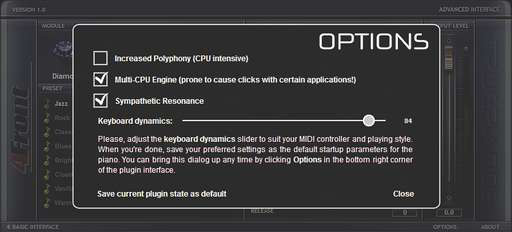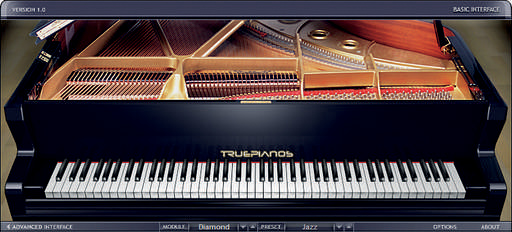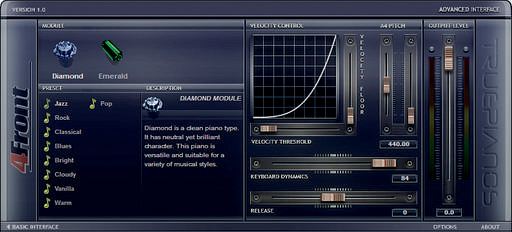MusicRadar Verdict
This lightweight piano is highly playable and relatively cheap. Optimise it for use with your MIDI controller keyboard and it becomes enormous fun.
Pros
- +
Great fun to play. Small disk and CPU footprint. Runs standalone and as a VSTi. Relatively inexpensive.
Cons
- -
Currently Windows-only. Little in the way of sound editing. No pedal noise/damper features as yet.
MusicRadar's got your back

4Front Technologies TruePianos

4Front Technologies TruePianos

4Front Technologies TruePianos
Pianos can seem a little out of place in our high-tech age. While most computer musicians record using some sort of keyboard, we'd bet that very few of them have an old Joanna in their studio.
The fact is, pianos and MIDI keyboards are very different beasts. They may look similar, but a significant part of a real piano's sound comes from the way that it feels.
Try playing any well-regarded piano plug-in using a cheap, unweighted MIDI keyboard and you'll see what we mean. You can marvel at the sheer fidelity of a sustained chord, but producing a meaningful performance can be very difficult.
Using a hammer-weighted keyboard can make a massive amount of difference but, for authenticity, the sensitivity of the keyboard must match the sound itself.
Hands on
This is where 4Front Technologies come in. TruePianos can be tweaked to suit your playing style and MIDI keyboard, and was born from 4Front's belief that none of the piano plug-ins or libraries currently available were as fun to play as the real thing.
4Front also felt that the ever-expanding multi-gigabyte libraries weren't bringing anything new to the table and that developers were blindly adopting a 'bigger is better' policy.
TruePianos uses a combination of proprietary sampling, synthesis and physical modelling techniques while simple controls enable you to match the instrument to your playing style.
The sound is generated in real time, meaning that there's no disk streaming, a low RAM requirement and very speedy load times.
The core engine was programmed by George Yohng, known for his free plug-ins and as the man who developed the audio engine for the Vienna Symphonic Library.
The piano modelling is based on analysis of various sampling sessions and was performed by Roel de Witt, resulting in the 32-bit 'footprints' used here for the piano modules.
In use
Each of the modules offers a number of presets that, as you may expect, are designed to put different slants on their basic sound.
At the moment, there are two modules available - Diamond and Emerald - but more are in the pipeline. Registered users will be able to download these for free.
TruePianos can be run as a standalone instrument or as a VSTi from within a host. Unlike some of its competitors, TruePianos doesn't offer built-in EQ, reverb or other processing, so if you require these tools, they'll have to come via other plug-ins.
If you want to get the best out of TruePianos, you need to ensure that the three tickboxes and one very important slider are all set up properly. With all the boxes ticked, there is no limit on polyphony, and both multi-CPU/core processing and sympathetic string resonance (on sustained notes) are enabled.
Sounds
So, how does TruePianos actually feel and sound?
We selected the Diamond module and the Jazz preset and, after a little adjustment of the Keyboard Dynamics slider, dived headlong into playing some improvised lounge jazz.
We haven't had so much fun jamming on a piano since, well, the last time we played on the real thing.
One of the Diamond module's strengths is its mellow tone. Some piano libraries/plug-ins can be a little too strident for our liking, so the softness you'll find here is refreshing. All of the other Diamond presets have an equally enjoyable feel and are eminently playable.
The Emerald module offers a more roomy sound which we found to be less satisfying. However, it does prove its usefulness by sitting well in the context of a mixed track.
We're not entirely convinced that TruePianos reaches the sonic heights of some of its purely sample-based rivals, but its sheer playability means that you can make it sound just as convincing.
It's easy to forget that sometimes, it's good to just enjoy playing an instrument - and in that sense, TruePianos is a blast.
Computer Music magazine is the world’s best selling publication dedicated solely to making great music with your Mac or PC computer. Each issue it brings its lucky readers the best in cutting-edge tutorials, need-to-know, expert software reviews and even all the tools you actually need to make great music today, courtesy of our legendary CM Plugin Suite.
“An amazing piece of history from the British blues scene”: Robert Plant is selling a trove of gear for charity – including a John Birch-modded ‘62 Stratocaster with two switches that once belonged to Stan Webb of Chicken Shack
“I was like ‘Wow, Coldplay were definitely listening to Radiohead and trying to make their version of it’": Porter Robinson says that he only recently discovered that Coldplay used to sound a bit like Radiohead
Why is tennis superstar Serena Williams being bombarded with microphones fired from confetti cannons? Allow us to explain…










